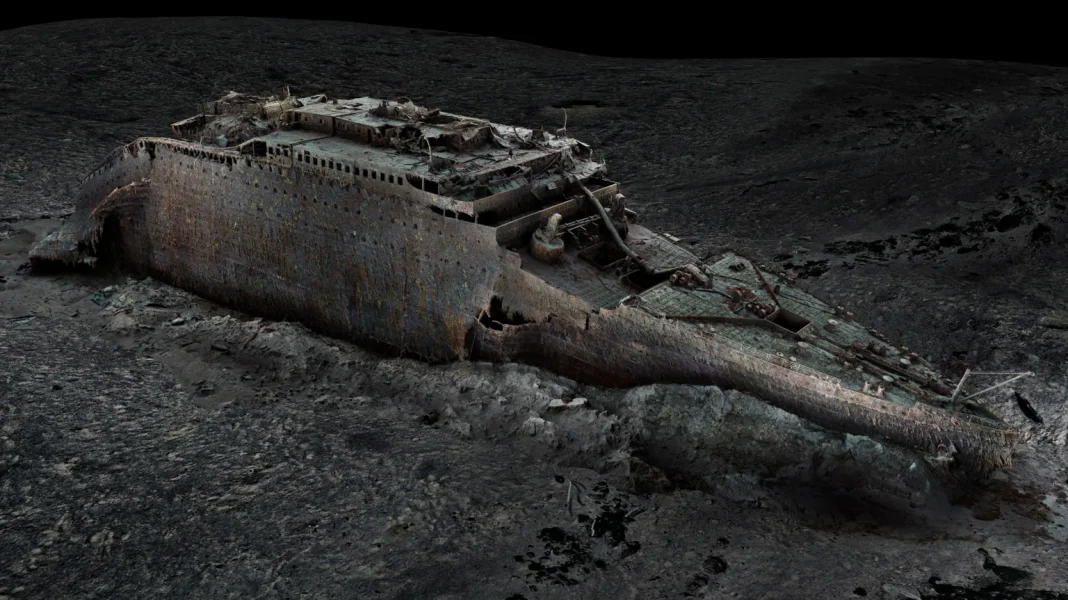This analysis of the Titanic’s digital scan reveals groundbreaking insights into the ship’s final moments, providing a comprehensive understanding of its tragic sinking. The creation of a 3D digital twin, using over 700,000 images captured by underwater robots, allows for an unprecedented examination of the wreck. Here are some key findings and their implications:
1. Structural Damage and Final Moments
The Titanic’s wreck is broken into two distinct sections: the bow, which remains upright on the seafloor, and the stern, which is severely damaged after its violent descent. The stern, having broken off mid-sinking, underwent a spiral motion as it plunged to the ocean floor, leading to significant damage. The massive engines in the stern area are surrounded by twisted metal, offering a stark visual of the destruction caused by the ship’s breakup.
2. The Boiler Room and Heroic Efforts of Engineers
One of the most poignant discoveries is the state of the Titanic’s boiler room, which was located in the rear of the bow section. Eyewitness reports had long suggested that engineers worked tirelessly to keep the lights on after the collision. The scan confirmed this, with visible evidence of the boilers still in a concave shape, indicating they were likely still functioning as the ship sank. Additionally, a valve found in an open position in the stern suggests that steam was still flowing, providing power to the ship’s electrical systems.
This technological discovery highlights the heroism of the engineering team led by Joseph Bell, who continued to shovel coal into the furnaces despite the increasing peril. Their efforts allowed the crew to launch lifeboats in some light, which may have contributed to saving lives.
3. The Iceberg Impact and Hull Damage
The new computer simulation, which used advanced algorithms and Titanic’s blueprints, has brought new clarity to the cause of the disaster. The iceberg’s impact left a series of punctures in a narrow section of the hull, not large holes but smaller punctures, roughly the size of an A4 piece of paper. This crucial detail underscores the narrow margin between Titanic’s survival and its sinking.
Though the ship was designed to stay afloat even if four watertight compartments flooded, the damage extended across six compartments. This sequence of small, seemingly insignificant holes gradually allowed water to flood the ship, overwhelming its design and causing it to sink. The simulation further illustrates the fine line between disaster and survival.
4. Survivor Accounts and the Iceberg’s Immediate Impact
The scan also supports survivor testimonies about the immediate effects of the iceberg’s collision. One of the most striking findings is the image of a porthole, likely broken by the impact of the iceberg, corroborating reports that ice entered passengers’ cabins. This adds an element of the immediate chaos that ensued after the ship struck the iceberg.
5. Titanic’s Continuing Legacy
As Parks Stephenson, a Titanic analyst, notes, the ship remains a “last surviving eyewitness” to the disaster. The wreck continues to tell its story through the scan, with new details emerging over time. For example, personal possessions of passengers, long lost to time, are scattered across the sea floor. These small artifacts contribute to the human story behind the tragedy.
Experts will continue to analyze the 3D scan, which is a massive task due to the scale of the wreck and the detail contained within it. This effort will likely uncover more secrets over the years, providing us with a deeper understanding of the Titanic’s final moments.
6. Long-Term Impact of the Scan
The digital scan is a critical tool for historians and researchers alike, as it provides the first comprehensive view of the Titanic’s wreckage. It allows for a more precise and detailed study of the ship’s structure, damage, and the final moments of the disaster. The scan’s ability to capture the wreck in its entirety is unparalleled and will continue to reveal important details for years to come.
In summary, this digital resurrection of the Titanic offers a profound new perspective on one of the most infamous maritime disasters in history. Through the combination of cutting-edge scanning technology, computer simulations, and expert analysis, we gain fresh insights into the ship’s tragic sinking, the heroism of the crew, and the narrow margins that led to the loss of over 1,500 lives. The scan not only enhances our historical understanding but also serves as a poignant reminder of the human lives lost on that fateful night in 1912.


